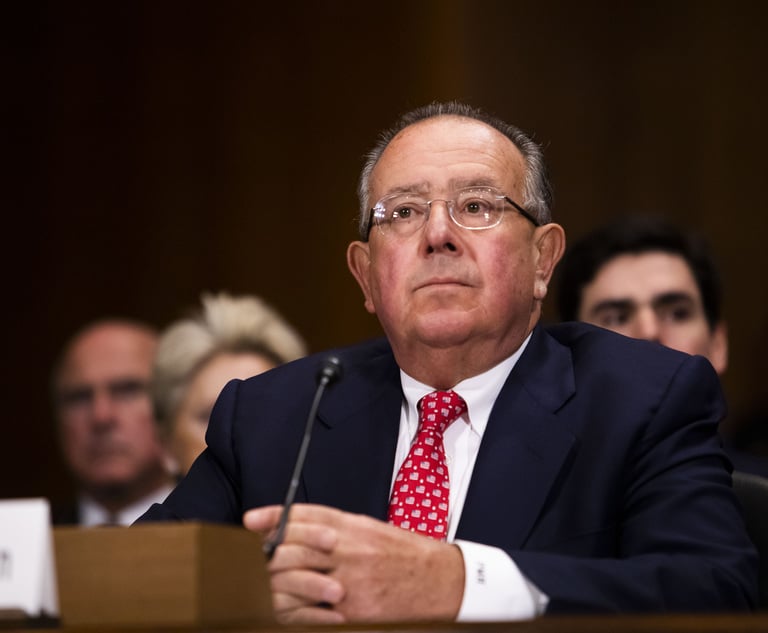Presumption of Death: What Happens When an Individual Vanishes From Society?
Recently, there has been new attention placed on the decades old disappearance of Kathleen Durst who disappeared in 1982. At the time of her disappearance,…
September 06, 2018 at 01:36 PM
7 minute read
 C. Raymond Radigan
C. Raymond Radigan
Recently, there has been new attention placed on the decades old disappearance of Kathleen Durst who disappeared in 1982. At the time of her disappearance, there was speculation and suspicion surrounding her husband Robert Durst who was from a prominent New York family. No one has heard from Kathleen Durst in decades, yet she was still considered a missing person until recently. Earlier this year, the First Department issued a decision finding the date of Kathleen Durst's disappearance was the most probable date of her death. Finally determining that Kathleen Durst was dead, and identifying her date of death may have implications in contemplated and pending proceedings by her family.
According to FBI statistics, 750,000 people are reported missing each year in the United States. USA Today, “By The Numbers: Missing Person in the USA.” Some of these disappearances are linked to mass fatalities or national disasters, while others may be associated with possible foul play. Regardless of the reason, when an individual disappears and their death cannot be confirmed, the family usually needs a death certificate or something similarly to file insurance claims, settle accounts or receive other benefits.
This article will review what occurs when a person is missing for an extended period of time.
Origins of the Presumption of Death and EPTL 2-1.7
As explained in In re Boerum St., 11 Bedell 321 (1903), under common law and civil law in many jurisdictions, a person was presumed to be living for a period of 100 years from the time of their birth. Some countries later modified this time period by statute. For example, one English statute exempted any person from penalty for bigamy if their spouse had been absent for a period of seven years. A similar English statute provided that parties to leases who were absent for more than seven years would be deemed deceased. Today, most jurisdictions have shortened the waiting period by statute and allow courts to dispense with the time period requirement all together if the missing person was exposed to a specific peril.
In New York, EPTL 2-1.7 governs presumption of death from absence. There are two routes that allow a court to presume death from a person's absence, which in turn permits the winding up and administration of the missing person's estate. Otherwise, one may have to resort to temporary administration proceedings for absentees pursuant to SCPA Article 9.
First, a court can declare an absentee legally dead if they were exposed to a specific peril. This concerns a disappearance under circumstances that strongly point to immediate death. A party must show that the absentee was exposed to a specific peril (and not just an unexplained absence), and that a thorough search was made for them. If these elements are satisfied, the absentee's date of death may be considered to be the date they disappeared.
If there is no specific peril linked to the absentee, a person can be declared legally dead if he or she has been absent for a continuous period of three years provided: a diligent search was made for the person during the three year period; the missing person has not been seen or heard from by anyone during that time period; and the missing person's absence is not otherwise satisfactorily explained. If these elements are satisfied, the absentee may be deemed to have died three years after the date such unexplained absence commenced or an earlier date if another probable date of death can be established by clear and convincing evidence. A booklet issued by some courts titled “Guidelines for Guardian Ad Litems” provides helpful hints about how to satisfy the court that a diligent and thorough search was undertaken.
The person wishing to invoke the presumption of death from a period of absence bears the burden of establishing the facts that may give rise to the presumption by the heightened standard of clear and convincing evidence (meaning it is highly probable that the person is dead). It is not enough to assert that three years have passed. A person's absence can be explained by a variety of circumstances other than death, including a desire to conceal their identity, a rift with family members or within a community, or the fact that the absentee was a “fugitive from justice.” See Gardner v. Northeaster Mutual Life Insurance, 152 Misc 873 (Sup Ct Delaware Co 1934) aff'd 242 AD 886 (3d Dept 1934).
Even if an unexplained absence and unreasonable failure to communicate are sufficiently established, the presumption of death from absence will not arise unless the petitioner satisfactorily demonstrates that he or she has conducted a thorough and exhaustive search for the absentee in places and among individuals likely to have information about the missing person's whereabouts. For example, in Cavanaugh v. Valentine, the court found that a diligent and exhaustive search to find an absentee was made only after the petitioner made a report to the Bureau of Missing Persons, sought police aid, visited the morgue, searched in places the absentee frequented, and attempted to get information from the absentee's relatives and friends.
In the case involving Kathleen Durst, the petitioner submitted evidence that she disappeared without explanation, and without her car and personal effects, on Jan. 31, 1982, see In re McCormack by Bamote, 161 AD2d 612 (1st Dept 2018). The evidence showed that Kathleen Durst had previously been very close with her sisters and communicated frequently, and it was inconceivable that she would abruptly cease all communication with family and friends. The evidence also showed that Kathleen Durst was a medical student two months away from graduation at the time of her disappearance, and it would be incomprehensible that she would walk away from her studies when she was so close to her goal. Based upon the unrefuted evidence, the First Department held that the clear and convincing evidence showed that Jan. 31, 1982, the date of her disappearance, was the most probable date of her death.
What Happens if an Absentee Is Located?
The presumption of death is only a presumption. If an absentee who was presumed dead later returns or is otherwise proven to be alive (the so-called “alleged decedent”), the presumption is nullified. Pursuant to SCPA 2226, if the “alleged decedent” returns, he or she has the right to any of her property that the fiduciary still has, as well as the right to compel an accounting and to enforce the decree made on the accounting. However, if the fiduciary accounted and the estate was fully distributed before the absentee returned, the absentee may not recover the property from the beneficiaries who received it. When the current version of SCPA 2226 was enacted in 1994, the Legislature noted that “[t]he distributees receiving the money after a final accounting are more entitled to protection than the missing person who shows up after a three- or five-year absence,” see Second Report of the EPTL/SCPA Legislative Advisory Committee (App. 22A); see Turano, Margaret, McKinney's Cons Laws of NY, SCPA §2226. This now conforms with SCPA §911 concerning determination and distribution of an absentee's estate.
Raymond Radigan is a former Surrogate of Nassau County and of counsel to Ruskin Moscou Faltischek. He also chaired the Advisory Committee to the Legislature on Estates, Powers and Trusts Law and the Surrogate's Court Procedure Act.
Jennifer F. Hillman is a partner at the firm where her practice focuses on trust and estate litigation. A special thank you to Gabriella Labita whose research paper was the basis for this article. She is a student at St. John's University School of Law.
This content has been archived. It is available through our partners, LexisNexis® and Bloomberg Law.
To view this content, please continue to their sites.
Not a Lexis Subscriber?
Subscribe Now
Not a Bloomberg Law Subscriber?
Subscribe Now
NOT FOR REPRINT
© 2025 ALM Global, LLC, All Rights Reserved. Request academic re-use from www.copyright.com. All other uses, submit a request to [email protected]. For more information visit Asset & Logo Licensing.
You Might Like
View All
Decision of the Day: Judge Dismisses Defamation Suit by New York Philharmonic Oboist Accused of Sexual Misconduct

Private Equity Giant KKR Refiles SDNY Countersuit in DOJ Premerger Filing Row
3 minute read
Decision of the Day: Judge Rules Brutality Claims Against Hudson Valley Police Officer to Proceed to Trial

Skadden and Steptoe, Defending Amex GBT, Blasts Biden DOJ's Antitrust Lawsuit Over Merger Proposal
4 minute readTrending Stories
Who Got The Work
J. Brugh Lower of Gibbons has entered an appearance for industrial equipment supplier Devco Corporation in a pending trademark infringement lawsuit. The suit, accusing the defendant of selling knock-off Graco products, was filed Dec. 18 in New Jersey District Court by Rivkin Radler on behalf of Graco Inc. and Graco Minnesota. The case, assigned to U.S. District Judge Zahid N. Quraishi, is 3:24-cv-11294, Graco Inc. et al v. Devco Corporation.
Who Got The Work
Rebecca Maller-Stein and Kent A. Yalowitz of Arnold & Porter Kaye Scholer have entered their appearances for Hanaco Venture Capital and its executives, Lior Prosor and David Frankel, in a pending securities lawsuit. The action, filed on Dec. 24 in New York Southern District Court by Zell, Aron & Co. on behalf of Goldeneye Advisors, accuses the defendants of negligently and fraudulently managing the plaintiff's $1 million investment. The case, assigned to U.S. District Judge Vernon S. Broderick, is 1:24-cv-09918, Goldeneye Advisors, LLC v. Hanaco Venture Capital, Ltd. et al.
Who Got The Work
Attorneys from A&O Shearman has stepped in as defense counsel for Toronto-Dominion Bank and other defendants in a pending securities class action. The suit, filed Dec. 11 in New York Southern District Court by Bleichmar Fonti & Auld, accuses the defendants of concealing the bank's 'pervasive' deficiencies in regards to its compliance with the Bank Secrecy Act and the quality of its anti-money laundering controls. The case, assigned to U.S. District Judge Arun Subramanian, is 1:24-cv-09445, Gonzalez v. The Toronto-Dominion Bank et al.
Who Got The Work
Crown Castle International, a Pennsylvania company providing shared communications infrastructure, has turned to Luke D. Wolf of Gordon Rees Scully Mansukhani to fend off a pending breach-of-contract lawsuit. The court action, filed Nov. 25 in Michigan Eastern District Court by Hooper Hathaway PC on behalf of The Town Residences LLC, accuses Crown Castle of failing to transfer approximately $30,000 in utility payments from T-Mobile in breach of a roof-top lease and assignment agreement. The case, assigned to U.S. District Judge Susan K. Declercq, is 2:24-cv-13131, The Town Residences LLC v. T-Mobile US, Inc. et al.
Who Got The Work
Wilfred P. Coronato and Daniel M. Schwartz of McCarter & English have stepped in as defense counsel to Electrolux Home Products Inc. in a pending product liability lawsuit. The court action, filed Nov. 26 in New York Eastern District Court by Poulos Lopiccolo PC and Nagel Rice LLP on behalf of David Stern, alleges that the defendant's refrigerators’ drawers and shelving repeatedly break and fall apart within months after purchase. The case, assigned to U.S. District Judge Joan M. Azrack, is 2:24-cv-08204, Stern v. Electrolux Home Products, Inc.
Featured Firms
Law Offices of Gary Martin Hays & Associates, P.C.
(470) 294-1674
Law Offices of Mark E. Salomone
(857) 444-6468
Smith & Hassler
(713) 739-1250






